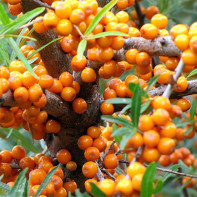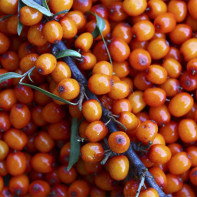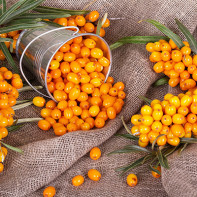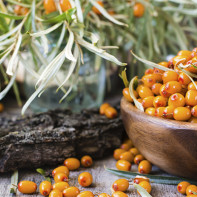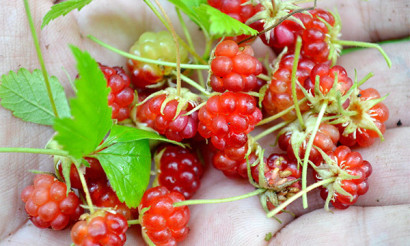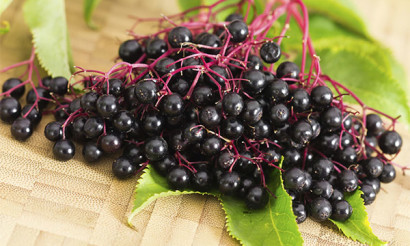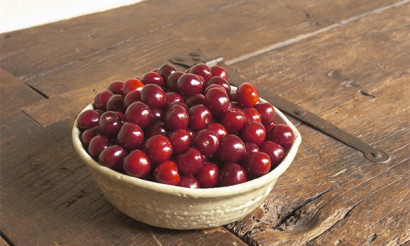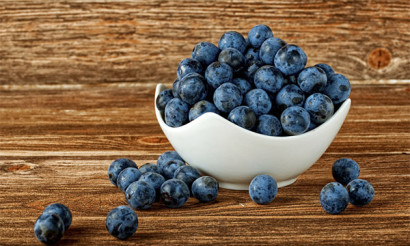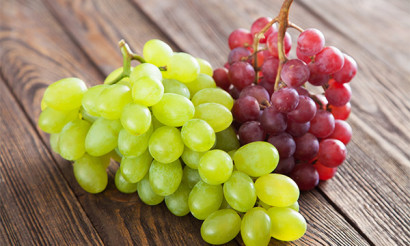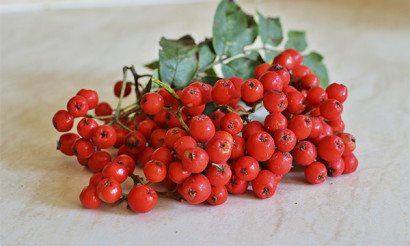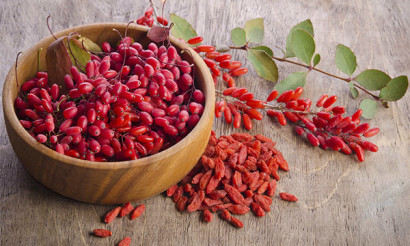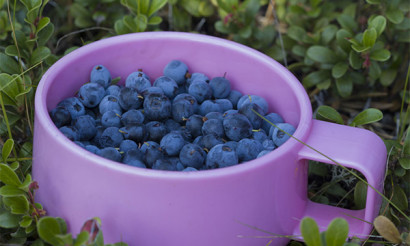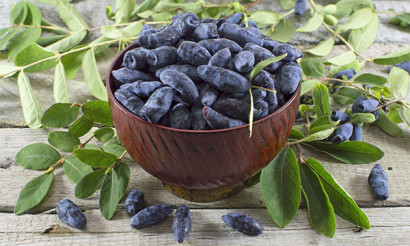Sea buckthorn: health benefits and harms
Sea buckthorn is a spreading shrub plant, the fruits of which contain many useful substances. It is bred as an ornamental plant, and for the sake of berries, while breeders are constantly working on breeding new varieties. Below we will consider the beneficial properties of the plant and its competent use in medicine and cosmetology, as well as a number of culinary recipes.
- What does sea buckthorn look like and where does it grow
- Types of Sea Buckthorn
- How to distinguish male from female sea buckthorn
- Composition and calorie content
- Useful properties of sea buckthorn
- General benefit
- For women
- For men
- During pregnancy
- When breastfeeding
- For kids
- When losing weight
- The benefits of sea buckthorn leaves, twigs and seeds
- Sea-buckthorn oil: properties and application
- What is useful sea buckthorn juice
- Sea buckthorn tea: benefits and harms
- Sea buckthorn in medicine
- With diabetes
- With colitis
- With pancreatitis
- With gastritis
- For the intestines
- For constipation
- With gout
- For the liver
- With hemorrhoids
- With cholecystitis
- With a cold
- With cystitis
- How sea buckthorn affects pressure
- Recipes of traditional medicine based on sea buckthorn
- Sea buckthorn in cosmetology
- For face
- For hair
- Harm and contraindications
- When to collect and how to store sea buckthorn
- How to collect
- Is it possible to freeze
- How to eat sea buckthorn
- Can I eat with bones
- What can be cooked from sea buckthorn: recipes
- Tea
- Juice
- Compote
- Jam
- Smoothie
- Morse
- Wine
- Marmalade
- Paste
- Is it possible to give sea buckthorn to animals
- Interesting facts about sea buckthorn
What does sea buckthorn look like and where does it grow
In the wild state, sea buckthorn is currently distributed practically throughout Eurasia, including not only Mongolia and China, but even partially tropical regions of India and Pakistan. It should be noted that sea buckthorn has been successfully growing in Russia for a long time not only in the European part, but also in Altai, and even in Siberia.

This shrub prefers floodplains of rivers and shores of lakes, provided that there are loose soils containing a lot of phosphorus and organic substances. But at the same time excessively moist soils do not suit her.
Almost all types of sea buckthorn are deciduous shrubs. Tree species are less common, which can reach a height of 3-6 m. Most forms of sea buckthorn differ in height, shape and size of the crown, leaf color, appearance of the fruit, which can be either round or oblong. As a rule, sea buckthorn is a dioecious plant. This means that these shrubs have both female and male individuals. In order for sea buckthorn to take root in the garden and bear fruit, you need at least one male bush for 4-5 female.
Fruits are drupes of a yellowish, delicious golden or orange color, with a peculiar taste and aroma. But not all species have edible fruits.
Types of Sea Buckthorn
Three types of sea-buckthorn are distinguished, which differ both in appearance and in their chemical composition of the fruits and even the area of growth.
- Tibetan sea buckthorn. It grows mainly in the high mountains of the Himalayas, but it also occurs in the lowlands of China. It is a stunted shrub covered with thorns. The fruits of this plant are edible, the local population uses them as a medicine for gastric pathologies. Tibetan sea buckthorn is a hardy plant, but in Russia it practically does not occur.
- Sea-buckthorn loosestrife. There are no thorns on the plant. It grows mainly in India and China. Tea is made from the leaves, and a preparation for cleaning gold and silver products is obtained from the fruits.
- Buckthorn buckthorn. It is a shrub that can reach 6 m in height. It differs in silvery young shoots, perennial branches are covered with dark bark and numerous long spines.
In Russia, for decorative and food purposes, buckthorn is grown. It is about her that we will discuss further.It differs in round smooth fruits of bright yellow or orange color (depending on the variety). Their smell can be called pineapple, because it resembles this tropical fruit.
How to distinguish male from female sea buckthorn
As already mentioned, sea buckthorn is a dioecious plant. Female specimens are distinguished by unisexual motley flowers. In male plants, the flowers are staminate. However, distinguishing one type of plant can be quite difficult. The fact is that flower buds are laid in late summer, when the intensive growth of annual shoots stops in length. And before the appearance of the buds, there are no signs that would help distinguish between male and female plants.
When buying seedlings, you need to pay attention to the kidneys. Female kidneys (pistillate) are smaller. Only 2-3 scales are formed in them, quite large in size. Male kidneys (stamens) are larger, they are about 2-3 times larger, and there are 5-8 pieces of scales on them, and sometimes it reaches a dozen.
In the future, after the opening of the buds, female plants differ in more intensive growth. In addition, their leaves are larger - this is how the plant adapts to pollination with the help of wind, since bees and other insects do not pollinate these flowers. Sometimes you can see how they collect pollen, but pollination does not occur.
Composition and calorie content
The energy value of sea buckthorn is quite high - 82 kcal per 100 g. On the other hand, these berries contain such a number of vitamins, minerals and unsaturated fats that you should not refuse it even because of the high calorie content. In particular, sea buckthorn is one of the few berries that retains vitamin C even after making juice or fruit drinks, not to mention freezing.
So, sea buckthorn berries contain the following beneficial substances:
- Ascorbic acid - up to 1300 mg, depending on the variety. It is believed that it provides the immunomodulating properties of this berry. Moreover, in terms of the content of this vitamin, sea buckthorn significantly overtakes even blackcurrant, which for a long time was considered a champion. Ascorbic acid is found not only in the fruits of sea buckthorn, but also in its leaves.
- Vitamins of group B, which participate in metabolic processes and have a very beneficial effect on the state of the nervous system.
- Provitamin A (60 mg) and Vitamin E (140 mg) are antioxidants that have anti-inflammatory properties that prevent premature aging. In addition, vitamin A is essential for vision, and E is essential for puberty.
- Vitamins K and P, which help normalize blood circulation.
- 15 different minerals, each of which is important for the normal functioning of the body. These include iron (to prevent anemia), magnesium (eliminates cramping), sulfur, silicon and many others.
- Up to 8% fatty oil.
- Organic acids and sugars.
- Useful for the human body tannins.
It is interesting that in the dark orange and red fruits of sea buckthorn there are much more antioxidants and carotenoids than in yellow and light orange berries. It is difficult to overestimate the value of antioxidants, since science has proved that they increase the body's immunity to certain oncological diseases. Moreover, such products are very rare in which tocopherol (vitamin E) would be present in such large quantities, and even in combination with carotenoids.
The berries of sea buckthorn also contain volatile, but in small quantities. However, in combination with vitamin C, they still have a beneficial effect on the body's immune system.
Useful properties of sea buckthorn
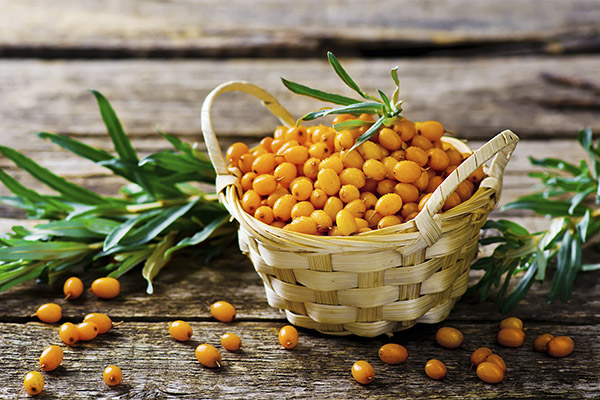
General benefit
The main advantage of this berry is that it helps to maintain health during the season of colds and viral diseases, when no other natural products are simply impossible to get. Its benefits are as follows:
- increase immunity;
- vision improvement;
- normalization of the skin;
- strengthening the heart muscle;
- increased vascular elasticity due to the high content of antioxidants.
From the fruits of sea buckthorn, oil is obtained, which also contains vitamins and various useful biologically active substances, including phospholipids, choline and sterols. The content of some of them in sea buckthorn oil is significantly higher than in fresh fruits, so it is considered an effective drug.
For women
For women, sea buckthorn is useful for several reasons. Firstly, its use helps prevent inflammatory diseases of the pelvic organs.
Secondly, during menopause, sea buckthorn greatly alleviates its effects and prevents unpleasant effects such as hot flashes. This is due to the so-called unsaturated fatty acids, which are part of its ripe berries.
Thirdly, the biologically active substances contained in berries ripened on the bushes and subsequently produced from them oil, have a very beneficial effect on the condition of the hair and skin. Moreover, they can be considered a universal “medicine”, since when eating berries, dry skin becomes smoother, moisturized after a few weeks, irritation and peeling pass. And for owners of oily skin, an unaesthetic gloss disappears, since these substances regulate the production of sebum.
For men
For men, sea buckthorn is useful for several reasons.
- It prevents erectile dysfunction.
- The berry is generally beneficial for the reproductive system, given the large amount of vitamin E that it contains.
- Sea buckthorn can be considered a natural energetic. It is very important for those who are engaged in physical labor or spend a lot of time in the gym, as it helps to maintain strength. In Japan, it even produces energy drinks for athletes.
- Finally, sea buckthorn contains serotonin, so that it can improve mood and relieve stress, which in itself is often a source of various troubles.
During pregnancy
During pregnancy, vitamin E is the most important substance, since it normalizes the production of hormones that help the baby to normally endure. It improves the maturation of the placenta, reduces the risk of its detachment, and prevents premature birth. In addition, it improves the well-being of the expectant mother, acting as an antispasmodic. Finally, it helps to avoid unaesthetic stretch marks. The champion of vitamin E is sea buckthorn. It also contains a lot of folic acid, which is very important for the development of the nervous system of the fetus.
Drinking sea buckthorn juice is only after consultation with a doctor, as well as consuming berries. But in general, during pregnancy, it is the best cure for such troubles as anemia, headaches, muscle weakness, decreased concentration and cognitive abilities. Sea buckthorn oil can be regularly used at home as a very effective external remedy for stretch marks.
When breastfeeding
During lactation, sea buckthorn is used with caution so as not to cause an allergy in the child. You need to start with a very small amount of juice or tea - in this form there is less chance of provoking an undesirable reaction.
Sea-buckthorn for a young mother is needed in order to tidy up the skin and hair, the condition of which deteriorates significantly during pregnancy. In addition, the berry allows you to fully compensate for the lack of vitamins in the postpartum period and normalize weight.
For kids
Sea-buckthorn in the form of berries is not given to young children. However, sometimes traditional medicine recommends using sea buckthorn oil directly for those babies who suffer from constipation. However, it is not taken orally. To normalize the process, rectal suppositories with sea buckthorn oil content are needed.
For children over 3 years old, sea buckthorn tea, juice or fruit drink are given in the absence of allergies.These funds help to boost immunity, they are also taken during colds and for home therapy for coughing.
When losing weight
Sea buckthorn not only allows you to get rid of extra pounds, but creates favorable conditions for this. In particular, it accelerates metabolic processes, and also reduces blood cholesterol.
It is best to use it in the form of juice or tea. A glass of such a drink should be drunk before each meal. By the way, it will help to withstand even the most rigorous diet. In addition, it can be combined with ginger, cinnamon or pineapple juice to enhance the effect. Such juice will also be useful before training, so that it gives the maximum effect.
The benefits of sea buckthorn leaves, twigs and seeds
Seabuckthorn seeds, more precisely, those dark bones that can be seen in berries, contain a lot of fatty acids. Sea buckthorn oil is obtained from them, the properties of which will be considered separately.
Useful for the human body are considered not only berries of sea buckthorn, but also its branches and leaves of the bush. In particular, the bark contains tannins that help in normalizing blood pressure and improve the condition of the gums.
The leaves contain the same vitamins as the berries of sea buckthorn. Therefore, they are also used as a medicine, and decoctions with pronounced healing and soothing properties are often made from them.
Sea-buckthorn oil: properties and application
Sea buckthorn oil is recognized by official medicine as one of the most effective natural remedies. It has antibacterial and regenerative properties, which allows it to be used by virtually every person to repair damaged tissues - skin or mucous membranes. Due to this, it not only heals wounds on the skin, but can also be used to restore the affected epithelium in gynecological diseases of various etiologies. And what is especially important - it actually does not have any strict contraindications for external use. The ether can be used for home treatment of diaper rash that appeared even for young children.
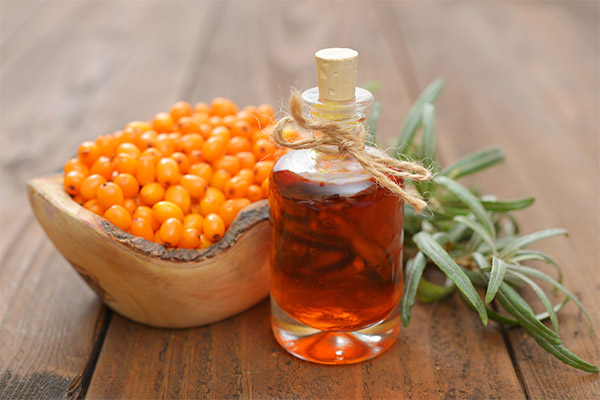
In gynecology, to this day, sea buckthorn oil is widely used by folk healers in the treatment of various kinds of inflammatory diseases of the pelvic organs, as well as for the prevention of such a widespread ailment as cervical erosion (especially since its antioxidants reduce the risk of dysplasia and oncology). It is also effective in cervicitis and endometritis.
Sea buckthorn oil in acceptable (small) amounts can be used without risk for the patient’s health to heal the mucous membranes of the stomach and intestines. It contains many vitamins that regulate metabolism and improve the absorption of nutrients, and with these pathologies this can cause problems.
What is useful sea buckthorn juice
In general, sea buckthorn juice is useful for the same reasons as its berries. After all, it contains all the same substances, and if it was prepared together with seeds, then fatty acids.
Sea buckthorn juice is the best tool for those who spend a lot of time at the computer. After all, it contains provitamin A, which supports normal vision. This vitamin is best absorbed in combination with fats, therefore it is better to drink the juice not by itself, but to add it to the smoothie, mixing with yogurt or milk.
Sea buckthorn tea: benefits and harms
Sea buckthorn tea is considered an excellent natural antiseptic and immunomodulator. It is prepared in different ways, including on the basis of juice or syrup from these berries, the recipes of which will be discussed below. You can also make it from berry puree, mashed with sugar and poured with boiling water (the concentration of berries can be adjusted at will). In addition, tea is useful for overwork because it provides the body with all the necessary vitamins.
However, tea should be used with caution.It is contraindicated in the presence of urolithiasis and cholecystitis, since it has a strong choleretic effect. It should also be used with caution in the presence of allergies.
Sea buckthorn in medicine
Sea buckthorn and the oil obtained from it are used in both official and traditional medicine, but only after consultation with your doctor.
With diabetes
Sea buckthorn leaves contain substances that normalize blood sugar levels. Therefore, with this disease, it is recommended to take an infusion of them - take 1 tbsp. in a glass of boiling water and insist for an hour.
Important: The glycemic index of sea buckthorn is 30 units.
With colitis
In the acute form of this disease, sea buckthorn is strictly contraindicated. In the stage of persistent remission, you can drink compotes and fruit drinks to normalize digestion and improve the condition of the mucosa.
With pancreatitis
In the acute phase of the disease, sea buckthorn is contraindicated in any form. In the stage of sustained remission, sea buckthorn oil is recommended, as it has enveloping, regenerating and anti-inflammatory properties. Also, fresh broths can be used to prepare decoctions that are recommended to be consumed in small quantities before meals to provide the body with vitamins and accelerate tissue healing.
With gastritis
With reasonable use, sea buckthorn is recommended for this ailment. It is especially useful to drink juice from its berries. It helps to activate the process of regeneration of the mucosa, as well as its speedy recovery.
For the intestines
In acute forms of inflammatory bowel disease, it is not recommended to use fresh berries of sea buckthorn and even oil from it. They can only be used in remission. Moreover, the oil helps to fight constipation and at the same time helps to heal the affected areas of the mucosa.
For constipation
For constipation, it is recommended to use rectal suppositories with sea buckthorn oil, which contribute to a soft and painless bowel cleansing. Regular consumption of sea buckthorn berries (unless there are no contraindications) will help normalize bowel function. The course of treatment is usually two weeks.
With gout
Berries of sea buckthorn remove excess uric acid from the body. Therefore, a handful of such fruits can be eaten for the prevention and treatment of gout. Also, with this disease, you can drink tea from it.
For the liver
Sea buckthorn berries and juice from them help to remove toxins from the body, establish fat metabolism, and improve the protective function of the hepatobiliary system. But although it is believed that sea buckthorn as a whole has a beneficial effect on the condition of the liver, it is worth consulting a doctor before using it.
With hemorrhoids
In this disease, not the berries themselves are usually used, but ointments and suppositories with sea buckthorn oil. The substances that make up their composition, firstly, prevent constipation (and they often contribute to the development of this disease), and secondly - help the quick healing of cracks.
With cholecystitis
With this disease, sea buckthorn is contraindicated in any form, whether it be fresh berries, juice, tea or stewed fruit.
With a cold
Sea buckthorn strengthens the immune system. Tea, fruit drink or sea buckthorn juice is the best preventive measure against seasonal colds. They can be drunk throughout the winter instead of taking synthetic vitamins and immunomodulatory drugs.
With cystitis
In folk medicine, sea buckthorn is often regarded as a remedy for cystitis. In fact, this disease most often has a bacterial nature, so antibiotics must be taken to treat it. Baths with sea buckthorn oil simply help to strengthen their action, relieve irritation and inflammation. To do this, pour 40 ml of oil into a container of warm water, stir, and then pour into a basin so that you can sit in the lower half of the body for 20 minutes. In this case, the legs need to be covered with a plaid or towel so that they do not freeze, and the liquid in the basin does not cool.After that, you should wipe yourself with a towel and lie under a warm blanket, so it is better to carry out the procedure before bedtime.
The duration of the course of treatment is at least 10 days in acute cystitis and about a month in chronic form.
How sea buckthorn affects pressure
About sea buckthorn, it cannot be said that it definitely has a beneficial effect on blood vessels. On the one hand, it strengthens their walls, so it can be considered a useful product in terms of normalizing pressure. On the other hand, sea buckthorn and juice from its berries have a strong tonic effect. In people who already have a predisposition to hypertension, this can cause an increase in blood pressure. Therefore, you can use sea buckthorn tea or juice only after consulting a doctor.
Recipes of traditional medicine based on sea buckthorn
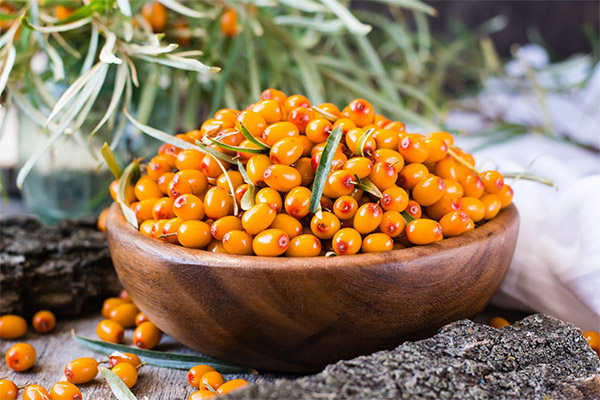
- With gastrointestinal diseases, it is recommended to take such a decoction - 1 tbsp. a spoonful of crushed dry sea buckthorn leaves in a glass of boiled water. Cooked in the usual way - bring to a boil, keep on low heat for 5 minutes, cool and filter. It is recommended to take the drug 200 ml 1-2 times a day.
- Another option is a decoction of fresh berries. Take 3 tbsp. 0.5 l of hot water, bring to a boil and leave for 10 minutes over low heat. Then filter and drink warm, but not hot, 2-3 glasses a day.
- From the berries of sea buckthorn make gruel, which is used for applications intended for the treatment of burns, suppuration and frostbite. Compresses are made from fresh leaves of sea buckthorn to treat rheumatism. They are also brewed, like regular tea, pre-rinsed under running water. They help relieve joint pain.
- With dermatological diseases, a decoction of dry leaves of sea buckthorn (10 tablespoons per 1 liter of water) is added to the bath to heal and eliminate irritation in the affected areas.
Sea buckthorn in cosmetology
For cosmetic purposes, both sea buckthorn berries and juice and oil are used, which can be independent means or the basis of masks and lotions.
For face
- You can wipe clean skin with sea buckthorn juice for a tonic effect. It is also advised to use it as lotions, moistening cotton pads in juice and applying to the skin for 12–20 minutes. This procedure is recommended to be repeated 2-3 times a week. It will give the skin a healthy appearance, eliminate irritation and redness.
- For dry skin, you can use the berries themselves, since they contain fatty acids. They are crushed in a mortar, fresh egg yolk is added and applied to the skin for 5-10 minutes, and then washed off.
- For dehydrated or withered skin, you can use sea buckthorn oil. It is added a few drops to a regular night cream for the face.
For hair
Sea buckthorn oil helps to make hair more thick and docile. It can be added to ready-made hair masks and balms. Sea buckthorn berries contain a lot of B vitamins, so they also prevent hair loss. This is especially important in winter, because in the cold season such problems are usually exacerbated.
- Take 300 g of fresh berries, crushed to a puree consistency, then apply to wet hair, cover them with plastic wrap and hold for an hour. After that, wash off the mask with ordinary shampoo.
- In order to improve blood circulation, ensure blood flow to the hair follicles and at the same time give them all the necessary vitamins, make a decoction of sea buckthorn berries (3 tablespoons per 0.5 l of water). It is rubbed into the scalp while still warm, then washed off. You can also make a decoction of the kidneys in the same proportion, it contains useful substances even in even greater concentration, but this remedy is available only in the spring.
Harm and contraindications
Despite the fact that sea buckthorn contains many valuable substances and has a wide range of healing properties, it can cause allergic reactions. In addition, sometimes it contributes to the deterioration of well-being in chronic liver diseases.
Therefore, sea buckthorn in all its forms is contraindicated in acute hepatitis, bile and urolithiasis, cholecystitis. You can not use it with allergies. Berries are contraindicated in all forms of gastritis, pancreatitis and peptic ulcer. But with the same pathologies in the stage of remission, sea buckthorn can be consumed in the form of juice.
When to collect and how to store sea buckthorn
Sea buckthorn can be stored in several ways - dried or frozen, in the form of jam, jam, pastille, compote or juice. Theoretically, you can even cook the butter at home by chopping the berries in a coffee grinder and pouring it with calcined olive or sunflower oil.
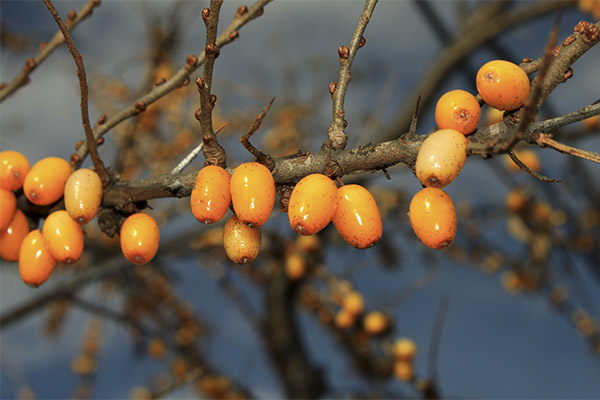
How to collect
Sea buckthorn is recommended to be collected in September or early October. At the same time, it is very important to keep the berries intact so that they can be processed and prepared for the winter. Various tools are used to automate this process. For example, it can be a special wire loop, which is called a “cobra,” a tube of thin sheet metal, to one end of which a bag for harvest is attached, as well as a special scraper made of a slingshot and a thin string stretched over it. These devices help to speed up the work, but do not guarantee that the berries will remain intact and beautiful.
Therefore, in many cases, manual harvesting is considered the preferred option. It goes slower, but it can be accelerated by cutting ripe “cobs” from the tree into which the berries gather. From a biological point of view, these are annual branches, the shoots of which dry out, so next year they will still not yield a crop. At home, it will be possible to calmly separate the berries from such a “cob”.
If the task is not to collect the whole berries, since they will still go to the juice, you need to wait for the first frosts, spread a clean piece of polyethylene under the tree and chop the branches. Ripe berries are crumbled, it remains only to sort them out.
If you plan to make juice from sea buckthorn, you can wash the berries directly on the bush, if you only point a hose at them. Then you need to put on tight gloves and squeeze the fruits, without separating them from the branch. Juice from them should drain into a previously prepared container. The resulting juice must be brought to a boil. This method is usually used in October, if the berries are in no hurry to crumble.
Is it possible to freeze
It is interesting that sea buckthorn berries are not afraid of frost even in natural conditions. Studies show that they retain all their beneficial properties. Therefore, sea buckthorn can be frozen, after washing and drying the berries. After that, they are poured into plastic food containers or tightly closed plastic bags and sent for quick freezing. Such blanks will be perfectly stored all winter.
How to eat sea buckthorn
Sea-buckthorn berries can be eaten fresh, but not everyone likes their sour taste, therefore they are often preferred in the form of marmalade, jam or marshmallows. For harvesting, the berries are taken whole, the seeds are not thrown out of them.
Can I eat with bones
Many believe that it is not worth consuming sea buckthorn berries with seeds, otherwise the risk of appendicitis increases. In fact, this is just a common myth that grandmothers scare kids, grabbing and pulling everything in their mouths. Inflammation of the appendix is in no way associated with ingestion of berry seeds. On the contrary, in the case of sea buckthorn, they are even useful because they contain a lot of healing substances.
What can be cooked from sea buckthorn: recipes
Marmalade, jelly, marshmallow, jam and jams are made from sea buckthorn berries. But from the leaves and twigs, you can make tea, which will have unique healing properties.
Tea
Although fresh or dried sea buckthorn berries can be brewed with ordinary tea, in fact, the leaves and twigs of this plant are much more beneficial. They are dried for the winter and crushed, and then tea is prepared. The recipe is simple - 1 tsp. dry raw materials in a glass of boiling water. To improve the taste, honey can be added. Such tea has a strong tonic effect and provides the body with vitamins.It contains many tannins that help normalize blood pressure. In addition, this tea gives beauty, improves skin elasticity.
If honey is not added to this drink, then it can be used as a medicine for herpes virus on the lips. They also rinse their mouth with gingivitis.
Juice
To prepare the juice, you need to sort out and rinse the berries, let the water drain, then squeeze the juice in a juicer. If there are few berries, then you can squeeze them even through a sieve or cheesecloth. Strain the resulting liquid and add sugar in a ratio of 1.5: 1. It is necessary that the sugar dissolves, so it is advisable to mix it. Pour the finished juice into previously sterilized glass jars and store in a cool place.
The second option is sea buckthorn juice with pulp. Berries need to be washed and dried. Then add 100 ml of water for each kilogram of berries and warm in a basin on low heat for 10 minutes. After this, wipe the sea buckthorn through a sieve and add sugar of 0.8 kg for each initial kilogram of raw materials. Then bring the mixture to a boil and pour into previously washed and sterilized bottles. It is recommended to drink 100 ml of this juice during the day in order to increase immunity and normalize the digestive system. The juice is quite concentrated, so it can be diluted with water.
Compote
For cooking, take 1 kg of sea buckthorn (fresh), 1 kg of sugar and 1.5 liters of water. It is best to choose slightly unripe berries for this. This compote is usually prepared in September. The berries are washed, dried, poured into prepared jars, then poured with hot sugar syrup, and put on pasteurization. For liter cans, heating is needed at 90 degrees for 15-17 minutes, and for less volume, 10 minutes at the same temperature is enough.
If desired, compote can be made more concentrated by reducing the amount of water and sugar - up to 0.5 kg per 1 liter.
Jam
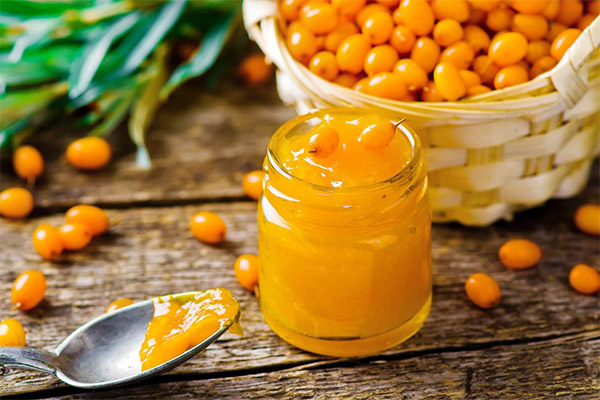
There are several options for sea buckthorn jam. The simplest recipe looks like this: 1.2 kg of sugar is taken per 1 kg of sea buckthorn berries. Berries are pre-sorted, leaving only ripe, whole and intact. Then they are washed and dried on paper towels.
The syrup is prepared as follows: 400 ml of water are brought to a boil, all sugar is added there and boiled again for 2 minutes. Then the prepared berries are poured with hot syrup and boiled for 10 minutes over low heat. The syrup is drained, boiled for another 10 minutes, cooled, filled with berries, boiled until tender. Then the jam is poured into pre-sterilized glass jars and closed with a sealed lid.
Smoothie
As a rule, smoothies are prepared not only with sea buckthorn, but also with some additional ingredients that improve the taste of the drink. For example, you can make smoothies from sea buckthorn, banana and pumpkin pulp. For 100 g of fresh berries, take 150 g of sweet pumpkin pulp, 1 banana, 100 ml of water and a pinch of cinnamon.
The berries are mixed with water, crushed in a blender to a puree consistency, filtered. Pumpkin pulp is cut into cubes, thrown into sea buckthorn juice. Sliced banana and a pinch of cinnamon powder are added there. All this is whipped in a blender until a homogeneous mass is obtained. It turns out a great autumn cocktail.
Morse
To prepare the fruit drink, you will need 300 g of sea buckthorn berries (fresh or frozen), 1 liter of water and 4 tbsp. ordinary granulated sugar. It is recommended not to chop the berries in a blender, but to grind in a ceramic or marble mortar. When a juice is released in a sufficiently large amount, it is carefully poured into a separate container, and the remaining mass is poured with clean water. The pan with this oil cake and water is put on fire, but it is not brought to a boil, and when bubbles appear in the container, they immediately turn off and filter.
Sugar is poured into the still hot pestilence and stirred until dissolved.Then pour juice filtered from the very beginning and mix everything again. The resulting fruit juice is recommended to drink chilled.
Wine
The simplest version of sea buckthorn wine is as follows: 1 kg of sugar and 2 liters of water are taken for 3 kg of berries. Berries are undesirable to wash. They must be immediately killed in the pulp (a mixture of peel and pulp). it is not necessary to do this manually, you can use a blender or a juicer. The juice is filtered through cheesecloth, and then poured into a pre-sterilized jar. At the same time, the pulp is mixed with sugar and poured with water. All this is insisted for 2-3 hours, then filtered again and mixed with sea buckthorn juice.
After that, a water lock is installed on the container (for example, in the form of a medical glove with a hole made in it through which gas will escape). This container is left in a dark and warm place for about a month and a half.
After 40–45 days, the fermentation stage is completed, a precipitate forms in the container, and the wine is drained from it using a filter. After that, the sea-buckthorn drink is poured into glass bottles, corked and kept for 60–90 days in a cool place in order to stabilize the product and make the taste more saturated.
Marmalade
Sea buckthorn marmalade is prepared in two ways. If there is agar-agar, then you can cook according to the following recipe: for 250 ml of sea buckthorn juice with pulp (it can be prepared in a blender from both fresh and frozen berries) you will need 80 g of granulated sugar, 5 g of agar-agar and 100 ml of water. Agar-agar is soaked in water, using a saucepan for this.
Juice is mixed with sugar, put on fire, brought to a boil and removed from heat. Then separately bring to a boil agar-agar mixed with water. After boiling, leave it over low heat for 1-2 minutes, stirring occasionally. The result should be a mass of viscous consistency. After this, the stewpan with agar is removed from the stove, the berry syrup is poured into it and mixed thoroughly. The resulting product is poured into molds and left to cool - during which time it should stabilize.
Delicious marmalade can be prepared without agar-agar, and apples containing pectin can be used for this. If desired, you can add gelatin, then the marmalade will be more elastic. But apples in themselves give a more delicate taste. For 600 g of sea buckthorn berries, take 350 g of applesauce, 2 tbsp. Sahara. Sea buckthorn is ground in a blender to separate the juice, which is then filtered through a large sieve. The remaining berry mass is mixed with applesauce and boiled about 1/3 of the initial volume. Then pour the resulting mass into a glass container, cool, tightly close the lid and put in the refrigerator.
Paste
This traditional Russian dessert can be prepared even from squeezed sea buckthorn. They are obtained as follows - they take 1 kg of berries, pour a glass of juice from quince, red currant or apples, since it has gelling properties. The juice with berries is heated until they become soft, then they are ground through a sieve, and the resulting mass is also passed through a meat grinder. To this volume of product add 600 g of sugar and mix it all with a mixer so that the grains finally dissolve.
Then the prepared mass is distributed on a wooden board so that a layer 1 cm thick is obtained. After some time, when it hardens as a solid layer, it can be placed in the oven, where it will need to be dried at a temperature of 45 degrees. The oven door must be kept ajar. When the pastille reaches the desired condition, it must be cut into cubes or rhombuses and sprinkled with powdered sugar, and then put in prepared dishes or a box (if the sweet is prepared as a gift for the holiday).
Is it possible to give sea buckthorn to animals
Some cats and dogs feeds include dried sea buckthorn berries in small quantities, which serve as an additional source of vitamins and minerals.
Some veterinarians recommend giving sea buckthorn oil to dogs and cats, but only in small quantities. This is best done in courses twice a year, in spring and autumn. In the spring - because at this time the least amount of vitamins (provided that the animal does not eat ready-made feed). In the fall - to prevent seasonal diseases that pets can also suffer. The main thing is not to overdo it, because the contraindications here are the same as when included in the human diet. The oil can also be used when caring for wool, but also without undue zeal. From time to time, 1 capsule per large breed dog will be more than enough.
Interesting facts about sea buckthorn
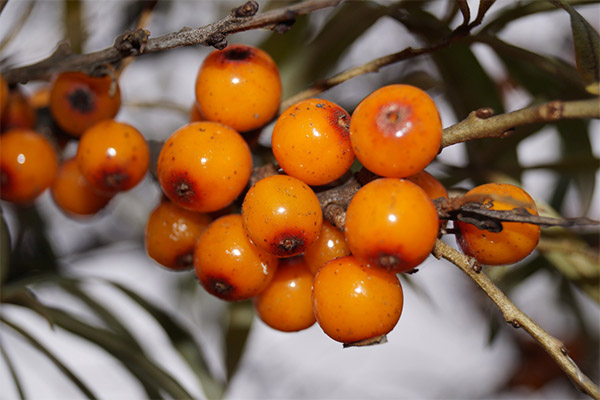
- The healing properties of sea buckthorn have been known since ancient times. However, in ancient Greece, she received the name "glossy horse." It is not known how widely it was used then in cosmetology, but people noticed that the horses eating these fruits acquired healthy glossy skin and a thick mane. Some legends claimed that the famous horse Pegasus gained his ability to fly precisely because he was eating sea buckthorn. However, this is only a myth.
- In ancient China, sea buckthorn was used precisely as a medicinal plant. It was believed that its regular use will give health and longevity - and this is long before the properties of antioxidants were discovered. However, despite such a long tradition of use, it was officially entered into the Pharmacopoeia only in the 1970s.
- In Japan, based on sea buckthorn, they produce energy drinks that are popular with athletes. In the 1980s, when the requirements were not so strict, such drinks were consumed by South Korean Olympic athletes. Currently, sea buckthorn products are included in the diet of the Russian space squad. And this is not surprising, because only 100 g of these berries per day can provide the human body with all the necessary vitamins and minerals, as well as a unique combination of organic acids.
- Sea buckthorn contains serotonin, called the hormone of happiness. Moreover, its concentration in berries is 10 times higher than in chocolate and bananas, which are considered leaders in the content of this substance.
«Important: all information on the site is provided exclusively in fact-finding purposes. Before applying any recommendations, consult with a profile specialist. Neither the editors nor the authors are liable for any possible harm caused materials. "

